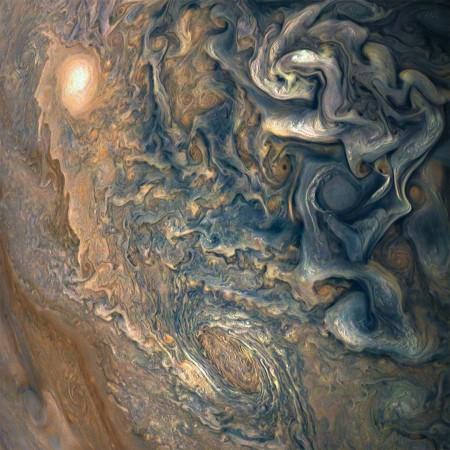
Treat yourself with this stunning new image of gas giant planet Jupiter, which has been taken by NASA's Juno spacecraft. The picture shows mesmerising hues of swirling clouds around the planet.
ALSO READ: Space fever: Astronauts on long journeys will be at the risk of this health hazard
Here are the top things you need to know about this amazing photo:
1. NASA's Juno took this image during its latest flyby on December 16, 2017, while the spacecraft was completing its 10th trip to Jupiter's northern hemisphere.
2. The image was shot at 9:43 am PST (12:43 pm EST) from a distance of 13,345 kilometres (approximately 8,292 miles), the space agency stated.
ALSO READ: NASA's Curiosity Rover spotted mysterious 'stick-like formations' on Mars
3. The spacecraft was at a latitude of 48.9 degrees while it snapped this image from the Jupiter's cloud tops. The image spatial scale is equal to 9.3 kilometres/pixel (5.8 miles/pixel).
4. So far, when the images and videos of Jupiter were previously captured, the spacecraft were always in the planet's equatorial plane. This is the first mission when an image of the gas giant has been captured by a craft while it was in Jupiter's northern hemisphere, over its polar region.
High Above the Jovian Clouds: This image of colorful, turbulent clouds in #Jupiter’s northern hemisphere was captured during my latest flyby of the planet https://t.co/zQ6OFl5WLC pic.twitter.com/NWMxnJzGwA
— NASA's Juno Mission (@NASAJuno) January 4, 2018
"We specifically designed the [JunoCam] to get pictures of the polar regions of Jupiter," Candy Hansen, a co-investigator of JunoCam, stated in a video, a Newsweek report said.
"All of our pictures are of the cloud tops. Jupiter is a ball of gas and all we will see are clouds," Hansen explained.
5. The image has been beautifully edited by citizen scientists -- Gerald Eichstädt and Seán Doran-- which makes the photo look like an oil painting. The image was taken by the camera attached to the Juno spacecraft, called JunoCam imager.
6. The colour of the cloud tops appear to be blue in the image because of the enhancements made in the photo by the citizen scientists, a report by Space.com unveiled.
ALSO READ: Guys beware! Sex robots will make men obsolete in the future
7. The $1.1 billion worth Juno mission was launched in August 5, 2011, from Cape Canaveral, Florida, with the aim of unveiling the mysteries of Jupiter, the largest planet of the solar system. The spacecraft took five years to reach Jupiter's orbit on July 4, 2016.

















